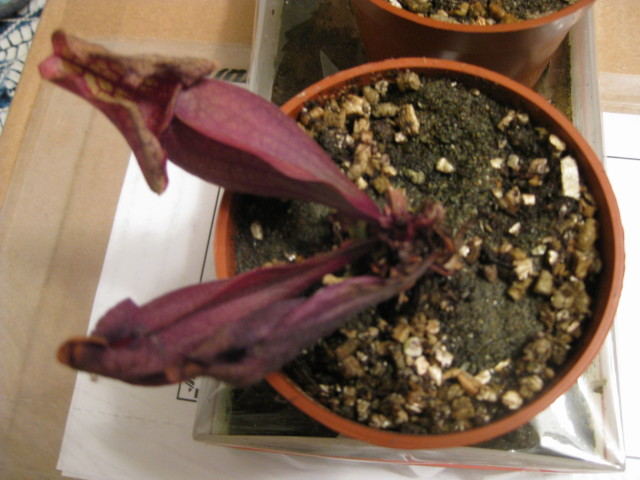Question
 Sarracenia purpurea
Sarracenia purpurea
I have had this sarracenia for 2 years now. It grows in a south facing window and I live in Vancouver, Canada (basically same weather as Seattle). It went through a dormant period over the winter and started showing signs of new growth in the spring (around March). It grew quite a few small pitchers, only about 1" tall. At the beginning of June I put it outside to get more direct sunlight - direct in the early morning (until about 10:00), filtered sun until about 3:00pm then direct sunlight for about 2 hours. At first it seemed to do okay, then the little pitchers started to show signs of drying, and eventually died back and I removed them. I keep it in a tray filled with rain water, and it is still in it's original potting mix. Once I put it outside, I didn't think to bring it in during the night so I'm wondering if cool night temperatures, down to 45 - 50 deg have forced into a dormant cycle again. The large pitchers on the plant will be in their 2nd year this year. I have brought it back inside to give it more stable temperatures but I'm really unsure what I should be doing at this point.
AnswerThank you for the detailed information and photograph. This type of information helps me out a lot.
Unfortunately, there are several important factors that affecting your plant, and it may be too extensive to cover each one in detail in this format. I will address the most relevant to the immediate situation. For the other factors, I'm going to give you resources to review.
The sudden die off of the new growth could have been due to two factors. The first is soil condition. Sometimes soil will breakdown or harbor bacteria that will kill off the roots. I'm not sure what your soil mix is, so if there is lots of nutrients from breakdown or bacteria (or improper soil ingredients), then you'll need to change the soil immediately. To determine if the soil is breaking down or harboring bacteria, scoop out a portion of the soil and sniff it. If it smells like soil, then it's still good. If it smells funky or like rotten eggs, it's time to change the soil.
The second factor is the sudden exposure to sunlight. The new growth is quite tender, and if you suddenly expose them to sunlight, they will burn. It's like going to Hawaii for the first time and laying on the beach all day. You'll end up with a severe burn. Same thing happens for plants. The older growth already had a tough waxy coat to protect it, but the new growth didn't develop it because it was growing indoors. In time, it will develop the waxy coat, but that takes time. Had the plant been growing outdoors at the time the new growth started to emerge, the new growth would have developed the protective waxy coat while it emerged. So what you saw may have been a normal response to the sudden exposure to sunlight.
Whenever you change growing conditions, it takes time for plants to acclimate. Yes the cooler temperatures and sudden exposure to sunlight would have affected it, but in time (a month or so), the plant would have adjusted and you would see new growth again. Now that you brought it back inside, the plant is getting mixed signals. Does it try to acclimate to indoor conditions or outdoor conditions? Even during the summer months, the nighttime temperature will be much cooler outdoors than inside your home. (At our nursery in Oregon, we typically drop down into the low 50s during the summer months.) This species grow rather slowly, and it takes a bit longer for it to acclimate.
I strongly recommend moving the plant back outdoors and keeping it there, for good. You can care for this plant outdoors throughout the year. It will survive very cold conditions with the proper winter care. We have customers in climates much colder than yours (including Toronto) that have successfully cared for their Sarracenia outdoors. The steps to do this is too extensive to cover in this format. For more information about this, I strongly recommend watching Volume 1 of the Grow Carnivorous Plants DVD series.
http://www.cobraplant.com/DVD
At the very least, read our care sheets on our main website:.
http://www.cobraplant.com/caresheets
Good growing!
Jacob Farin






